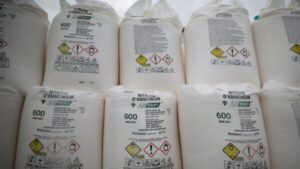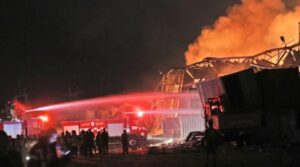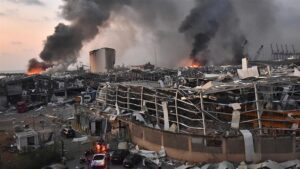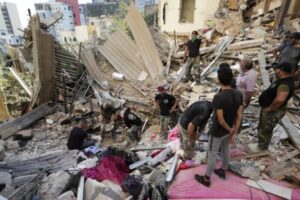Beirut and Why You Need a Hazmat-Accident Contingency Plan
September 4, 2020
Downtown Beirut provides a grim reminder of why you need a Hazmat-Accident Contingency Plan.

One might think that the colossal explosion of 2.75 thousand metric tons of ammonia nitrate in downtown Beirut is just one more reason why Lebanon is on almost nobody’s Bucket List for retirement travel. But wait. There’s more!
This latest Mideast tragicomedy provides some absurdities to contemplate for those of us here in the Good Old USA, living as we do in relatively saner & safer environs ruled by warring politicians who, thankfully, are mostly subclinical in their narcissistic craziness.
How so? Let’s consider ammonium nitrate itself, also called NH4NO3, but better known by the highly-scientific and esoteric moniker: fertilizer.
The backstory on ammonium nitrate
 Ammonium nitrate is usually pelleted. And according to Jimmie Oxley, a professor of chemistry and explosives expert at the University of Rhode Island, “…(it) normally sits nicely and behaves itself until you do something catastrophic to it.”
Ammonium nitrate is usually pelleted. And according to Jimmie Oxley, a professor of chemistry and explosives expert at the University of Rhode Island, “…(it) normally sits nicely and behaves itself until you do something catastrophic to it.”
And what might that be? Well, top of the list is storing it for a long period of time, whereby the pellets will absorb moisture, “aggregating into rock-like blocks and becoming more sensitive to shocks,” according to Andrea Sella, a professor of inorganic chemistry at UCL in London.
Lebanese authorities confess that the tons of NH4NO3 had been languishing in a downtown-Beirut warehouse in the city’s port for more than six years, which is definitely past the “best if used by” date on the package.

A fire started, causing an initial blast, compressing the NH4NO3, and thereby instigating a second blast estimated to be somewhere between .30 and .70 kilotons—producing a shockwave that killed 100+ and injured thousands.
Doing the math, the force of the explosion was 30- to 70-percent as strong as your garden-variety 100 megaton nuclear warhead, of which the US and Russia together have about 3,200 coursing under & around the seven seas: a comfort to us all.
So why are we telling you this?
Because if ever there were a compelling reminder that many otherwise-benign chemicals will become lethal when inadvertently mixed with other chemicals, heated, or compressed, etc., Beirut provides the mother of them all. You need a plan. Now.
Tragically, following the initial blast, a fire started compressing the NH4NO3, and thereby instigating a second blast estimated to be somewhere between .30 and .70 kilotons—producing a shockwave that killed 180+ people and injured thousands.
Does your company have a contingency plan to deal with possible hazmat disasters?
Okay, you’re probably not storing 2.75 thousand metric tons of ammonia on site. If you are, leave the building immediately, and do not turn on-or-off any lights as you egress. That said:
No commercial or industrial enterprise that involves chemicals or petroleum is immune to the possibility of a disaster.
No matter how large or small your enterprise, you need to consider the environmental damage that might be caused by a spill, fire, or explosion for which you will ultimately be held legally and financially responsible, regardless of whether such a disaster is manmade (e.g. stupidity) or an Act of God (e.g. a tornado).
Decide today: what’s a disaster?
 The onset of a disaster is not the time to begin a discussion about whether you’re actually experiencing one—whether major or minor. And the definition of a disaster shouldn’t be left to employees’ ad hoc interpretations of what’s occurring as the fertilizer hits the metaphorical fan.
The onset of a disaster is not the time to begin a discussion about whether you’re actually experiencing one—whether major or minor. And the definition of a disaster shouldn’t be left to employees’ ad hoc interpretations of what’s occurring as the fertilizer hits the metaphorical fan.
This is important because recognizing an unfolding disaster should instigate a well-defined and rehearsed contingency plan, with all employees knowing what triggers its implementation.
Our advice: no matter how benign the potential effect, the possible release of any amount of hazardous material into the environment should thrust your contingency plan into motion.
This is especially true if circumstances are going to attract attention from mainstream news media, which (if you haven’t noticed) are prone to sensationalize anything having to do with hazardous waste.
Who’s in charge?
Keep in mind that a disaster has no regard for your organizational chart, so that who should be in charge during an environmental emergency might not be the person who’s running things during your normal operations.
Thus, it’s important to develop an Incident Command System, wherein once the emergency is declared, authority and responsibilities are clear, unequivocal, and without regard to the usual departmental boundaries.
Your disaster planning should map out exactly what must be done during the first hours, days, and weeks of an incident, with responsibilities delegated to specific personnel at each juncture to ensure no important detail, is inadvertently neglected that might later become a legal liability.
Keep things uncomplicated
Each step of your contingency plan should be stated in simple language and well-rehearsed.
During an emergency, adrenaline kicks in while “executive processing” checks out. That means that personnel won’t be in the right state of mind to read and evaluate pages of instructional do’s and don’ts, but they can effectively execute simple, well-rehearsed assignments.
Ensure all your personnel is aware of your contingency plan and that each knows his or her role within it. Provide regular training to educate new employees and keep current ones qualified. And run drills—some planned and some a surprise—to improve your contingency plan and assess employee readiness to implement it quickly and effectively.
Printed copies of your contingency plan should be kept offsite as well as onsite in places that are intuitive and easily assessable to employees. Web copies are best kept in a secure cloud-based platform and assessable from virtually anywhere on any device.
Summary
A suitable contingency plan for contending with possible accidents and disaster scenarios is your first defense against the financial, legal, and political damage caused by any disaster that involves hazardous waste. The first step is to identify your operation’s greatest vulnerabilities.
While it might not be possible to foretell how an unplanned event will exactly impact your business, you can nonetheless develop a contingency plan that will lessen the degree of damage to your operations, your reputation, and—ultimately—your finances.
Get expert advice about developing your contingency plan here.
And thanks for reading our blog!

